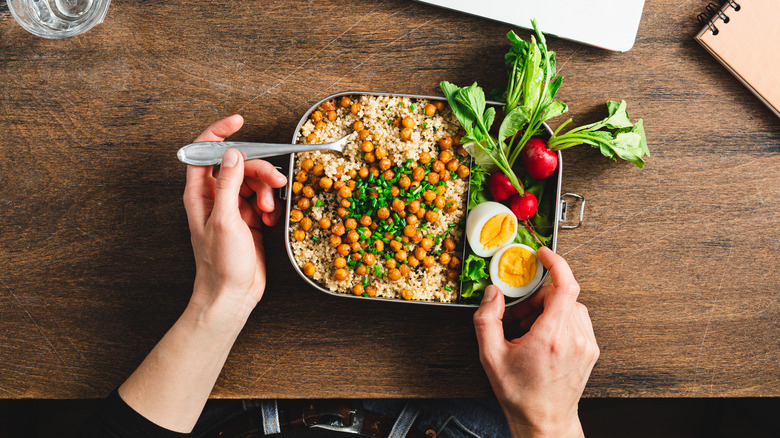The Cholesterol-Lowering Foods You Can (And Should) Eat Every Day
Brown rice, broccoli, salmon, and other cholesterol-reducing foods can certainly benefit our health on their own. But people with high cholesterol may want to double up on a few of these food items by combining them into one satisfying meal — specifically, whole grains and legumes. Not sure how to incorporate these two ingredients into your daily diet? Stay tuned for some deliciously easy recipe ideas.
Findings of a 2022 study published in Current Developments in Nutrition that involved more than 16,000 participants found that from 2013 to 2018, over 11% of adults at least 20 years of age were found to have high cholesterol (hypercholesterolemia). Adults ages 40 through 59 were found to be most predominantly affected. According to the U.S. Centers for Disease Control and Prevention (CDC), hypercholesterolemia occurs when a person has a total cholesterol measurement that exceeds 200 mg/dL. Diet is a major contributing factor to the condition, particularly diets that are high in saturated and trans fats. Whole grains and legumes, however, contain compounds known as plant sterols and plant stanols (via Forbes). Here's how these naturally-occurring substances may help us lower high cholesterol levels without the use of medication.
How whole grains and legumes may help lower cholesterol
Plant sterols and stanols are two types of phytosterols. Research shows that phytosterols can cut down the amount of cholesterol absorbed into our intestines by half, according to a 2017 scientific review published in Arquivos Brasileiros de Cardiologia. This produces reductions in LDL cholesterol levels, otherwise known as "bad" cholesterol. In addition, phytosterols are also thought to boost the excretion of cholesterol from the body. However, most of us could stand to increase our intake of phytosterols. Consuming 2 grams of phytosterols daily has been linked with an 8% to 10% decrease in LDL cholesterol, but most Americans are getting only about 300 milligrams of these compounds each day.
In a 2012 study published in the Journal of Cereal Science, researchers examined the bioactive compound makeup of wheat grain and bran. As outlined in the research, cereals are among some of the most phytosterol-rich food sources, with the greatest amounts found in the bran and germ fractions of wheat grain. As for legumes, researchers from a 2018 study published in the Journal of Agricultural and Food Chemistry analyzed dietary phytosterol intake among people in China. Legumes were found to have the second-highest concentration of phytosterols with 129.6 to 275.6 milligrams per every 100 grams.
Meal ideas for combining whole grains and legumes
Brown rice and beans aren't your only options when it comes to getting creative in the kitchen. The Grains & Legumes Nutrition Council has no shortage of recipe suggestions for breakfast, lunch, dinner — even dessert. Here are some of our favorites.
For breakfast, we're fans of peanut butter and strawberry overnight oats. The rolled oats take care of the whole grains, and peanut butter checks off the legume box. That's right, peanuts are classified as legumes rather than nuts (via Harvard Health Publishing). Not a peanut-butter enthusiast? Here's another healthy overnight oats recipe for you to try — this one with maple syrup and cinnamon. As your stomach starts growling for lunch, we suggest carrot and chickpea pilaf. The ingredients include 1 cup of brown rice and a 420-gram can of chickpeas to ensure you're getting plenty of whole grains and legumes in one go. To mix things up for dinner, try your hand at a broad bean whole grain pasta dish, and top it off with a pea pesto sauce.
For our favorite meal of the day (dessert!), you can't go wrong with a batch of chocolate-hazelnut truffles. As recommended by the U.S. Department of Veteran Affairs (VA), this mouth-watering recipe incorporates rolled oats and chickpeas, giving you a sweet end to a day of cholesterol-lowering meals.


